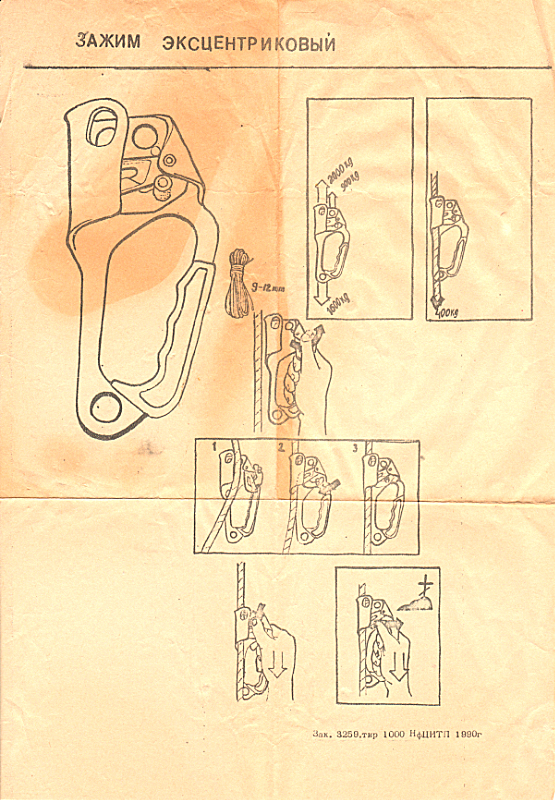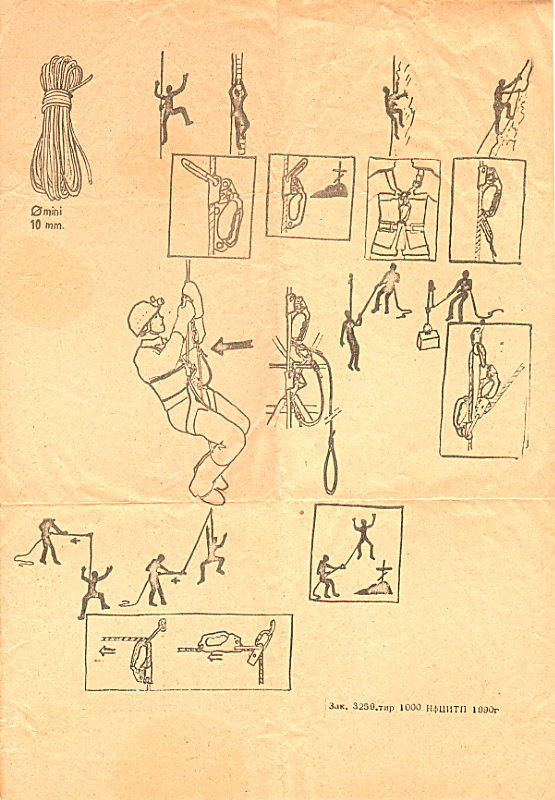Overview
I am not sure what order to put these in. The following table summarizes the main differences, and illustrates why determining the order by a consistent progression of features is not possible:
| Version |
Shell |
Handle |
Cam |
Tooth Pattern |
| Version A |
Painted |
Black |
Plated |
(4.1)(2S2.1S1)^2(1S1)^3(1.2) |
| Version B |
Painted |
Black |
Plain |
(4.1)(2S2.1S1)^2(1S1)^3(1.2) |
| Version C |
Anodized |
Black |
Plated |
(4.1)(2S2.1S1)^2(1S1)^3(1.2) |
| Version D |
Anodized |
Red |
Plain |
(3.2)(1S1)^1(2.1.2) |
| Aktru |
Painted |
New Black |
Plated |
(3.4)(1S1.2S2)^2(1S1)(2.3) |
I chose this order because Version A has the poorest quality, Version B is also painted, and Version D has a different cam design than the others. Each of these is a copy of a Petzl Ascension. The Aktru handle matches a Petzl Ascension design that came out in 1998, while the other versions match earlier Petzl handgrips.
[ Top
| Version B
| Version C
| Version D
| Aktru
| Return to H.E.C. Ascenders
]
Version A
(#2340)
Technical Details
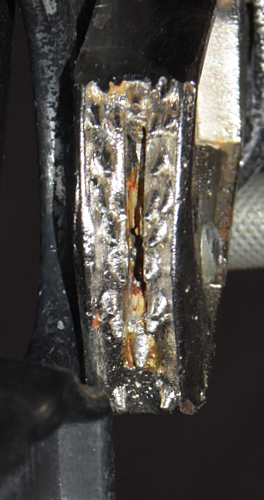 I acquired this Альтурс Зажим эксцентрик (Al’turs Eccentric Clamp) from Alexander Starkov in 2017.
I acquired this Альтурс Зажим эксцентрик (Al’turs Eccentric Clamp) from Alexander Starkov in 2017.
This version is 193 mm.
tall, 87 mm.
wide, 29 mm.
thick, and weighs 215 g.
The rope channel is 17 mm.
wide. The cam radius increases from 40 to 53 mm. over an angle of 37°, giving a 25° cam angle. The tooth pattern is (4.1)(2S2.1S1)^2(1S1)^3(1.2).
The shell on this ascender is painted, and the cam is plated.
There are no markings on this ascender.
Unlike the others on this page, the cam on this ascender is poorly cast, with noticeable porosity. The bends forming the rope and cam channels are also somewhat crude, with some creasing instead of smooth semicircular bends. For these reasons, I suspect that this is the oldest ascender on this page.
[ Top
| Version A
| Version C
| Version D
| Aktru
| Return to H.E.C. Ascenders
]
Version B
(#2164, 2905)
Technical Details
I acquired this ascender in 2017 as part of Bob Thrun’s collection. I acquired a second one from Ed Sira at the 2019 NSS Convention.
Version B is 193 mm. tall, 91 mm. wide, 27 mm. thick, and weighs 199 g.
The shell is a tall irregular shaped stamping made from 3.6 mm.
aluminum alloy sheet metal. The shell is painted. A 16 mm. wide rope channel is formed in the upper
portion of one side and a smaller cam channel lies opposite the
first. A hole drilled through both sides of the cam channel accepts
a 6 mm. semi-tubular rivet. The cam and cam spring are mounted
on this rivet. The head of the rivet sits into a stamped depression
on the back of the shell, while the roll is exposed on the open
side. There is a cylindrical cam stop riveted to the shell above the cam.
The handle below the cam has a soft black plastic hand grip
molded into place. The hand grip has four finger grooves. A 15 mm.
sling attachment hole is punched below the handle opening. This
hole is slightly beveled. A 19.2 by 13.3 mm. hole through both sides
of the rope channel provides an attachment point just above the
cam. A second 17.7 mm. hole above the cam provides a second top attachment point.
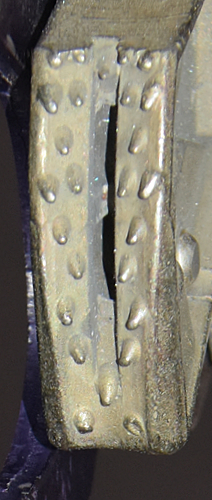 The cam is a skeletonized steel casting. The cam radius increases from 40 to 54 mm. over an angle of 36°, giving a 24° cam angle. The cam has
number of small conical teeth, all of which have their axes approximately
parallel to the lower surface of the cam. The cam face is divided by a vertical slot designed to provide
clearance for mud. The tooth pattern is (4.1)(2S2.1S1)^2(1S1)^3(1.2), where the "S"s stand for
the single longitudinal mud removal slot. Like many other ascenders, the inner cam face radius
reduces from top to bottom to accommodate various sized ropes.
The cam is a skeletonized steel casting. The cam radius increases from 40 to 54 mm. over an angle of 36°, giving a 24° cam angle. The cam has
number of small conical teeth, all of which have their axes approximately
parallel to the lower surface of the cam. The cam face is divided by a vertical slot designed to provide
clearance for mud. The tooth pattern is (4.1)(2S2.1S1)^2(1S1)^3(1.2), where the "S"s stand for
the single longitudinal mud removal slot. Like many other ascenders, the inner cam face radius
reduces from top to bottom to accommodate various sized ropes.
A spring-loaded manual safety bar is mounted on the bottom of
the cam with a steel semi-tubular rivet. The normal action
of the spring holds the safety against the cam. When the cam is
opened, the shell interferes with the safety bar, thus preventing
opening the cam. If the safety bar is moved away from the cam
(opposing the spring), it will clear the shell and the cam will
open. At full open the safety can be released and the spring will
hold the safety against the back of the shell. This provides a
means of locking the cam open. A knob on the safety bar assists
in operating the safety mechanism. The
knob is a two piece mechanism consisting of
a threaded rivet fixed to the safety, and a knurled cylinder which
screws onto the rivet. This allows the cylinder to be screwed
down against the safety where it does not project very far, or
unscrewed about 6.7 mm. to make it easier to operate with
gloved hands.
There are no markings on this ascender other than a printed sticker. The sticker has "Туристическая Фирма" (Tourist Company), a logo, "Альтурс" (transliterates as Al’turs) "630064 r. Новосибирск" (Novosibirsk), "уп. Ватутина" (the Belgorod area), along with telephone and fax numbers.
This ascender is a direct copy of one of the Petzl Ascension ascenders. Although there are tool marks on the shell, the overall quality is reasonable.
The instructions call this a "Зажим эксцентрик," which roughly translates as "eccentric clamp."
[ Top
| Version A
| Version B
| Version D
| Aktru
| Return to H.E.C. Ascenders
]
Version C
(#2165)
Technical Details
 I acquired this ascender in 2017 as part of Bob Thrun’s collection. Bob purchased it in September 1994.
I acquired this ascender in 2017 as part of Bob Thrun’s collection. Bob purchased it in September 1994.
Version C is 193 mm. tall, 90 mm. wide, 28 mm. thick, and weighs 193 g.
The shell on this ascender is anodized, and the cam is plated.
There are no markings on this ascender.
This ascender does not show tool marks like Version A does. It is also anodized instead of painted. Both of these are minor improvements. I'm indifferent about plating the cam.
[ Top
| Version A
| Version B
| Version C
| Aktru
| Return to H.E.C. Ascenders
]
Version D
(#1942)
Technical Details
I acquired my Version D from Philipp Molzer in 2013.
Version D is 193 mm. tall, 89 mm. wide, 28 mm. thick, and weighs 191 g.
 The shell is a tall irregular shaped stamping made from 3.9 mm.
aluminum alloy sheet metal. A 16 mm. diameter rope channel
is formed in the upper portion of one side and a smaller cam channel
lies opposite. A hole drilled through both sides of the cam channel
accepts a 6 mm. semi-tubular rivet. The cam and cam spring are mounted
on this rivet. The handle below the cam has a hard plastic hand
grip molded into place. The hand grip has four finger grooves.
A 14.9 mm. sling attachment hole lies below the handle opening.
A 19.4 by 13.4 mm. hole passes through both sides of the rope channel,
providing an attachment point just above the cam. A 15.1 mm. hole is punched next to this one. None of the attachment
holes are rounded or beveled.
The shell is a tall irregular shaped stamping made from 3.9 mm.
aluminum alloy sheet metal. A 16 mm. diameter rope channel
is formed in the upper portion of one side and a smaller cam channel
lies opposite. A hole drilled through both sides of the cam channel
accepts a 6 mm. semi-tubular rivet. The cam and cam spring are mounted
on this rivet. The handle below the cam has a hard plastic hand
grip molded into place. The hand grip has four finger grooves.
A 14.9 mm. sling attachment hole lies below the handle opening.
A 19.4 by 13.4 mm. hole passes through both sides of the rope channel,
providing an attachment point just above the cam. A 15.1 mm. hole is punched next to this one. None of the attachment
holes are rounded or beveled.
The cam is a plated skeletonized steel casting. The cam radius increases from 39 to 51 mm. over an angle of 36°, giving a 22° cam angle. The cam has number of small blunt conical teeth. The tooth pattern is (3.2)(1S1)^1(2.1.2). Like most eccentric
cam ascenders, the inner cam face radius reduces from top to bottom
to accommodate various sized ropes.
The cam safety is a machined
aluminum lever mounted on a 3 mm. roll pin in the same shell
channel as the cam. A second spring mounted on this roll pin serves
as a safety spring. Normally this spring holds the safety where
it blocks the cam from opening. When the end of the safety lever
is depressed, the opposite end pivots upwards so that the cam
is no longer obstructed. The safety supports a two piece mechanism consisting of
a threaded rivet fixed to the safety, and a knurled cylinder which
screws onto the rivet. This allows the cylinder to be screwed
down against the safety where it does not project very far, or
unscrewed about 7.8 mm. to make it easier to operate with
gloved hands.
There are no markings on this ascender.
Phillip wrote the following note about this ascender:
This is a Jumar-like ascender, but not made by Jumar. Maybe Russian? I got it in a used climbing gear store in Kathmandu and used it myself for caving.
This resembles some of my other Russian ascenders, so I tentatively supported Phillip’s hypothesis about it’s country of origin. Once I acquired Bob Thrun’s Version B, I was able to positively identify this as an Альтурс ascender.
This ascender is similar to certain Petzl Ascension ascenders, but the workmanship is poor. The attachment points have sharp edges. Even if they had been rounded, I would recommend using a small maillon
for most attachments in order to reduce the risk of sling abrasion.
The lower attachment hole could theoretically have the same safety
problems as the one on Clog Version A.
The upper rope attachment hole is located very close to the main
rope. A carabiner through the upper oval attachment hole will
drag on the main line.
The slot in the cam is intended to reduce the risk of ascender
slippage due to mud-caked cam teeth. This may be of some benefit
under certain caving conditions, particularly with wet non-cohesive
silty mud. My experience is that caves that have enough mud to
clog ascender teeth usually have enough mud to stop a bulldozer.
Most ropes muddy enough to stop other ascenders
will stop this one too, despite the mud holes. Although I have
not tried this ascender in the appropriate conditions, I suspect
that the holes will not eliminate the icing problems common to
other toothed cam ascenders.
This ascender is easy to operate with
the proper hand, but still difficult to operate with the opposite
hand.
[ Top
| Version A
| Version B
| Version C
| Version D
| Return to H.E.C. Ascenders
]
Aktru
(Актру)
(#3639)
Technical Details
I acquired my Aktru (Актру) from Artyom Babin (Артём Бабин) in 2024.
The Al'turs Aktru (Альтурс Актру) is 193 mm. tall, 89 mm. wide, 30 mm. thick, and weighs 217 g.
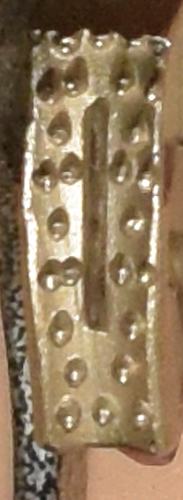 The shell is a tall irregular shaped stamping made from 4 mm.
aluminum alloy sheet metal. A 15 mm. diameter rope channel
is formed in the upper portion of one side and a smaller cam channel
lies opposite. A hole drilled through both sides of the cam channel
accepts a 6 mm. semi-tubular rivet. The cam and cam spring are mounted
on this rivet. The handle below the cam has a hard plastic hand
grip molded into place. A 14.98 mm. sling attachment hole lies below the handle opening and a 9.5 mm hole lies beside the first.
A 18.9 by 13.5 mm. hole passes through both sides of the rope channel,
providing an attachment point just above the cam
The shell is a tall irregular shaped stamping made from 4 mm.
aluminum alloy sheet metal. A 15 mm. diameter rope channel
is formed in the upper portion of one side and a smaller cam channel
lies opposite. A hole drilled through both sides of the cam channel
accepts a 6 mm. semi-tubular rivet. The cam and cam spring are mounted
on this rivet. The handle below the cam has a hard plastic hand
grip molded into place. A 14.98 mm. sling attachment hole lies below the handle opening and a 9.5 mm hole lies beside the first.
A 18.9 by 13.5 mm. hole passes through both sides of the rope channel,
providing an attachment point just above the cam
The cam is a plated skeletonized steel casting. The cam radius increases from 38 to 54 mm. over an angle of 40°, giving a 26° cam angle. The cam has number of small blunt conical teeth. The tooth pattern is (3.4)(1S1.2S2)^2(1S1)(2.3). Like most eccentric
cam ascenders, the inner cam face radius reduces from top to bottom
to accommodate various sized ropes.
The cam safety is a machined
aluminum lever mounted on a 3 mm. roll pin in the same shell
channel as the cam. A second spring mounted on this roll pin serves
as a safety spring. Normally this spring holds the safety where
it blocks the cam from opening. When the end of the safety lever
is depressed, the opposite end pivots upwards so that the cam
is no longer obstructed. The safety supports a two piece mechanism consisting of
a threaded rivet fixed to the safety, and a knurled cylinder which
screws onto the rivet. This allows the cylinder to be screwed
down against the safety where it does not project very far, or
unscrewed about 7.8 mm. to make it easier to operate with
gloved hands.
There are no markings on this ascender. There are remnants of two stickers. One appears to be a price label and the other, now highly deteriorated, appears to be from Al'turs.
Артём wrote that this ascender was from the 1990s. I place it from 1998 or later since the Aktru handle and the frame hole arrangement matches a Petzl Ascension design that came out in 1998.
The shell shape and shell reinforcement have changed from those on the earlier versions.
The cam is similar to the cam on the other Al'turs versions (which are also similar to pre-1998 Petzl Ascension cam designs), but the tooth pattern is different. The teeth are rounded and the overall cam casting quality is fair at best.
[ Top
| Version A
| Version B
| Version C
| Version D
| Aktru
]



